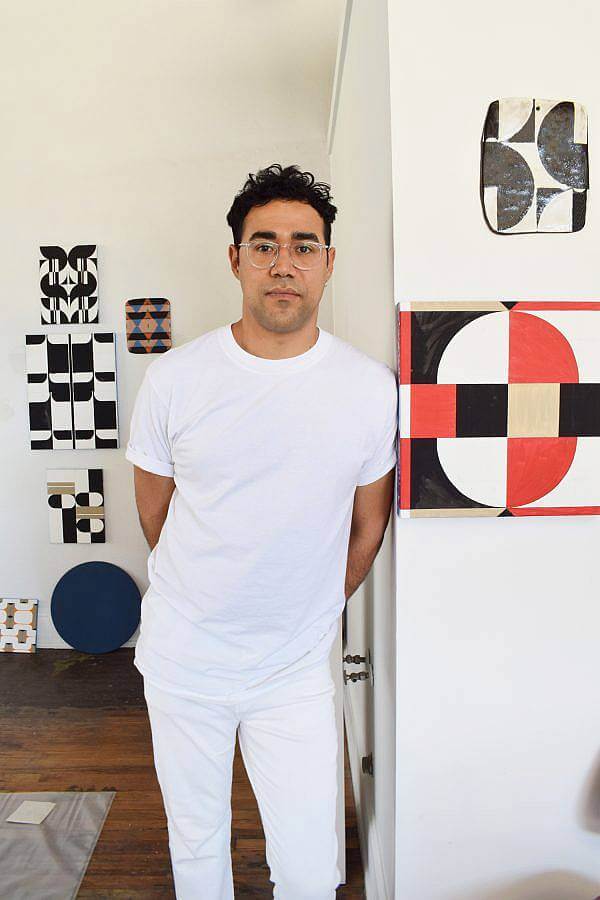Can you tell us a little bit about who you are and what you do?
Hey! Well, I was born in South Central Los Angeles, where I was brought up by a single mother who escaped the civil war in El Salvador in the 80s. I come from a family of dairy farmers and construction workers. I eventually moved to San Francisco to get my BFA at San Francisco State University. For the last four years, I was living in Brooklyn, NY where I had a studio and was working as an art handler. In the fall of 2020, I moved to Kansas City with my partner and we moved our studios into a new building, which also gave us the opportunity to open up our gallery space The Ekru Project. Recently, I’ve been enjoying my time curating exhibitions and writing for The Coastal Post and other platforms. Aside, from writing and my curatorial endeavors, I’m mostly known for my abstract geometric paintings, but I’ve recently expanded my practice to include ceramics. Color and pattern have always been an integral part of my process, and the exploration of new material has recently informed more of the textural side of my work.
My works are built up with layers of mixed mediums. From afar, the work appears clean, simple, reductive, but upon closer inspection, they’re raw, textural, and gestural. Inspired by architecture and design, my works are abstract yet structured, displaying a huge variance in composition as well as my interest in color theory. Many of the pieces have distinct patterns and repetitive forms, portraying a rhythm. Others are more erratic, showing a less rigid composition.

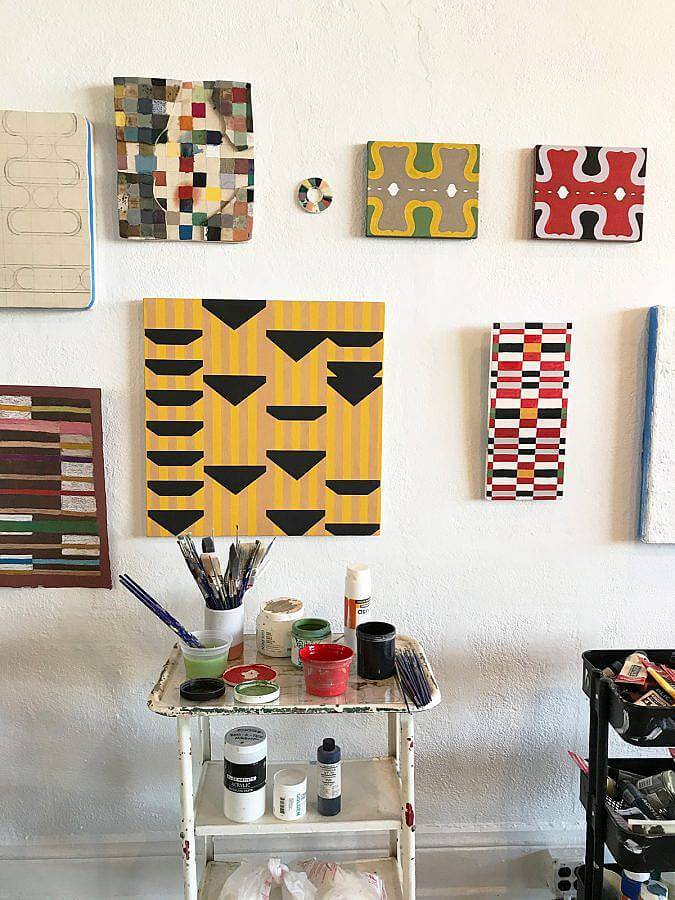
Tell us about The Ekru Project. How did it begin?
The Ekru Project is a gallery and online platform that was founded by me and my partner, Emily Reinhardt (The Object Enthusiast). It started as a long-distance curatorial project between the two of us when we were living in separate cities. We used it as a way to highlight and share artists and their work that we felt inspired by. When we moved into our building in Kansas City, we realized we had the space to bring that conversation to life and open our gallery.
We’re focused on contemporary, emerging, and underrepresented artists. At the moment we’re working on building the gallery from the ground up. We’re constantly searching for creators to exhibit and interview. It’s a passion project that has brought us a great amount of joy. At times like these, we feel it’s important to support creators of all sorts, who are paving their way through the world.
Does the space have any upcoming shows or events?
Yes, on May 7th our next exhibition Mazes, Microcosm, Mitosis opened, featuring the works of Sophia Belkin, Jackie Slanley, Noël Morical, Nina Kintsurashvili, and Megan Reed. The show was curated by Baltimore artist Danni O’Brien, who will have a solo in our space during the month of June.
I’ve just finished programming for the rest of the year and I’m feeling pretty great about the artists we’re exhibiting here at the gallery.
What is your favorite thing about living and working in Kansas City?
I’ve made some really incredible friendships since moving here last fall. I have felt so welcomed by the local artists and the creative community here. By moving to KC, I’ve been able to have more space for my work and my creative endeavors – room to think bigger and make some mistakes while I’m at it. Having lived in larger cities, it’s been a welcomed change of pace.
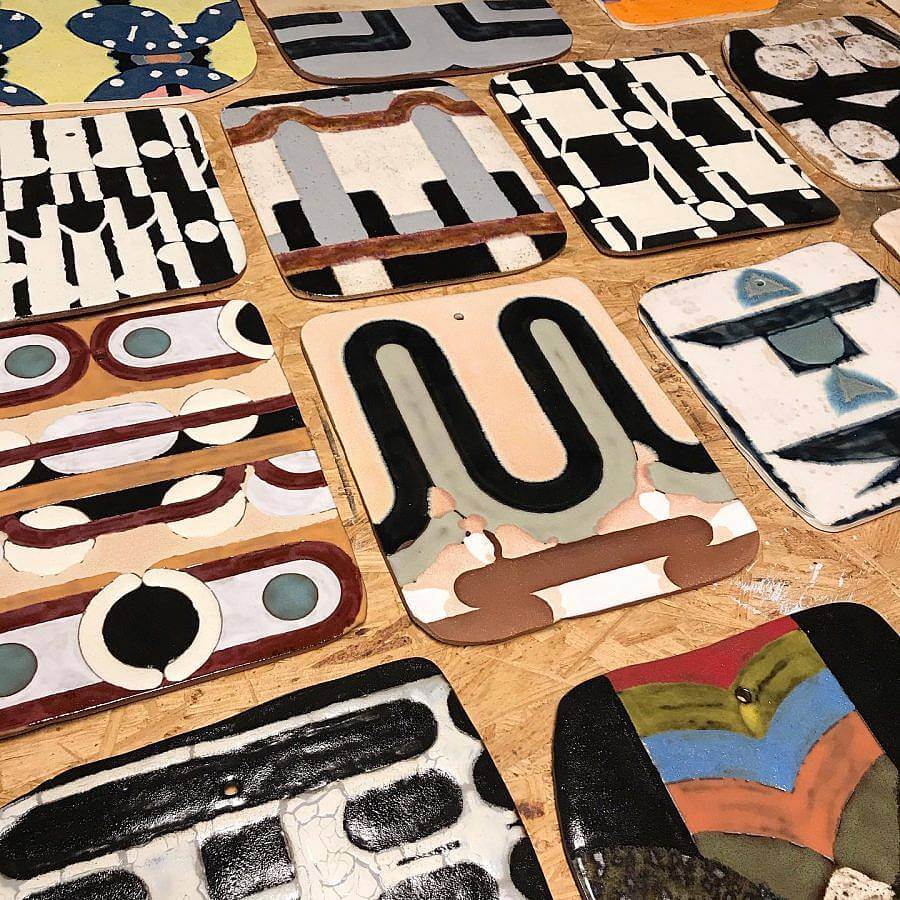
What is your making process like? Do you work on multiple pieces at once?
There are two important lessons that I’ve taken to heart throughout my artistic career. The painter Chris Martin advised me to always work on multiple pieces at once. I have found that once these pieces are together they inform one another. It allows me to build on the body of work, and not just the singular piece. The other advice was given to me by Dan Walsh. He simply told me to keep showing up everyday. Even if you feel that you’ve reached a point of satisfaction or despair, just keep producing, and always aim to grow and expand your practice. I’ve learned the best way to do this is to just keep showing up to the studio everyday.
Ceramics take weeks or sometimes months just to finish a piece since it’s a delicate, and time-sensitive process. This in a way, forces me to work on multiple pieces at one time. I usually build and make my slabs several at a time while they dry and set up, preparing for their first firing. After the bisque, my slabs are ready for the planning portion of the composition. I take the time to draw these designs out before I start applying any glaze. After the glaze is meticulously applied, they’re fired in the kiln for a second time. This is the exciting part, and opening the kiln often feels like an exciting surprise.
When it comes down to painting, I start off constructing the panels from repurposed wood. Occasionally I have to make a trip to the lumber yard. I love working with gouache, acrylics and oils. The paintings are meticulously layered with a mix of marble dust, paper mache, sand, and other textural mediums. The raw paint is applied laboriously through technical methods, from dry brushing into the canvas’s weave, to complex layering techniques: each application calls attention to the materiality of each individual component. I rely heavily on painting as an object.
My way of working is very investigative, I sometimes value the process over the final product. It’s the experience of each and every step that awakens me, it’s what I find most romantic about my practice. My work is often preplanned, sketched and measured before I start, but I love exploring new techniques and improvising in the moment. I like that I have the freedom to deviate from the initial plan and adapt to the situation.
How has your work or perspective about your work changed since starting working in ceramic?
Ceramics has been the first step toward a new way of working for me, and I’ve only scratched the surface. The process of glazing my composition onto a slab of clay has shown me what can happen if I relinquish control of the medium and allow the process to take its natural course. It’s that moment when I feel confident enough to try a new approach and innovative ways of using the materials to push my work into a new direction. I want to have the time to discover more about it and pursue the work that crosses the realms of craft and fine arts. Working in ceramics has encouraged me to step outside my comfort zone and to explore other means of expression. I’m embracing the freedom and accepting the new challenges. I’ve strayed away from my mechanical approach to geometric paintings and opening up to new concepts and subjects to talk about. Now, I’m experimenting with new techniques. While still expanding my ceramic vocabulary and taking classes at my local ceramic studios.
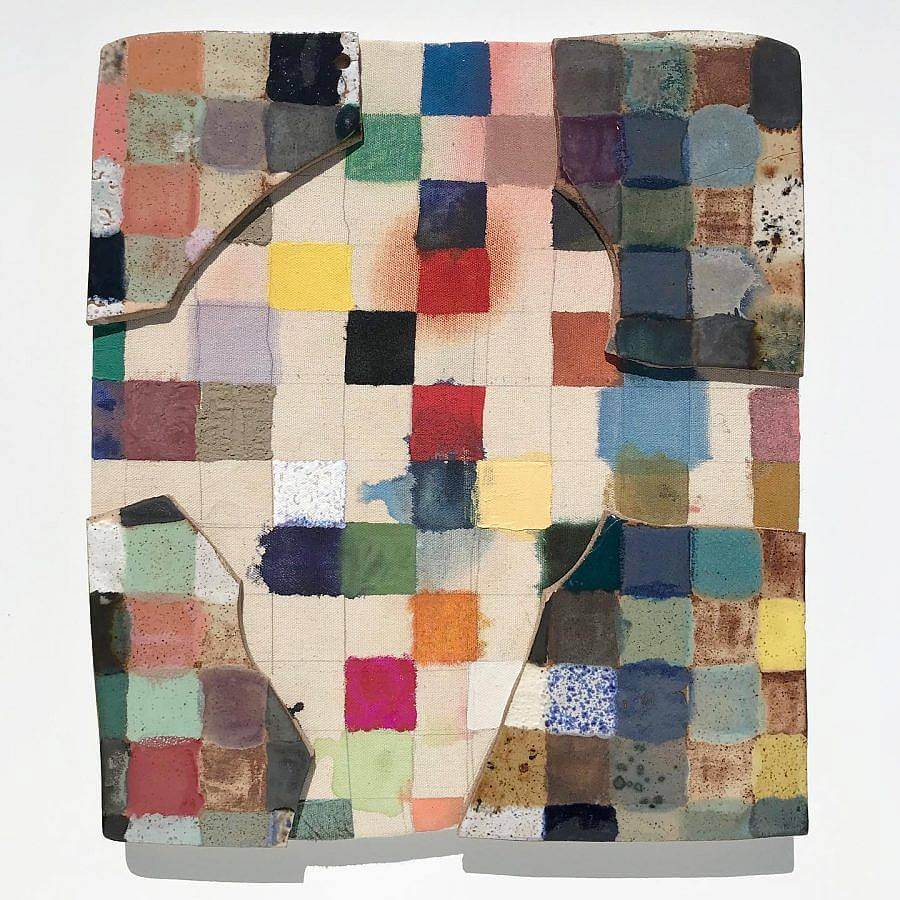
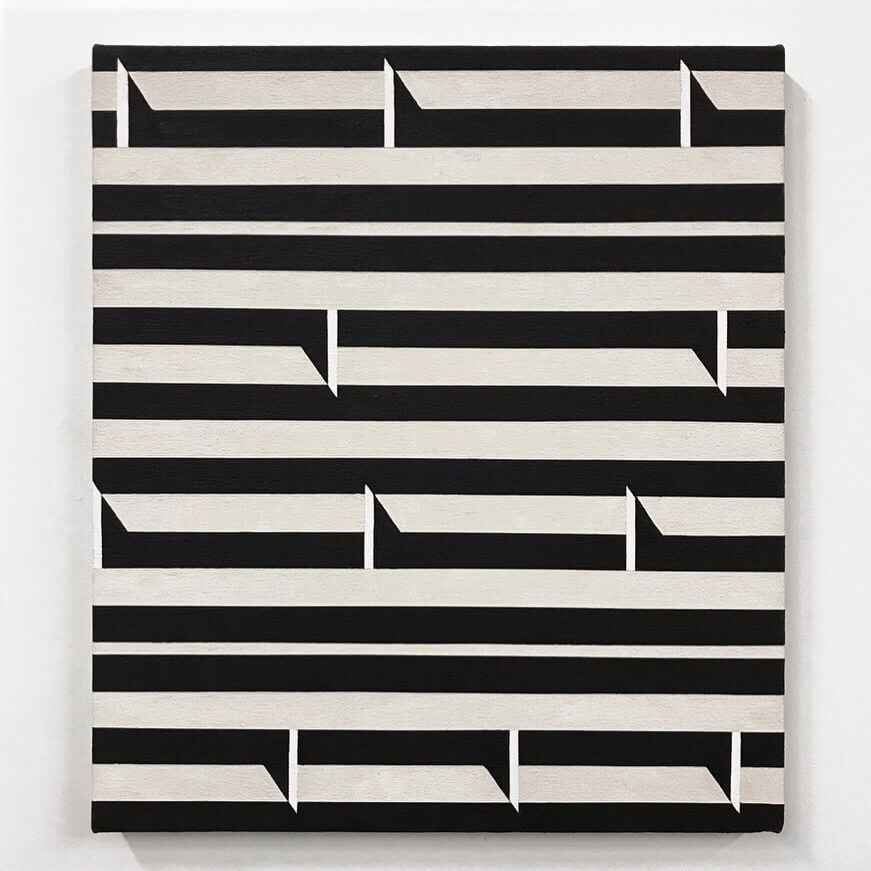
There is so much chance and mess involved in using ceramic and glaze as materials– yet your ceramic pieces are as symmetrical, clean, and geometric as your paintings. How do you deal with this material contradiction?
It’s a dance that I’m still getting used to. It’s a level of respect for the chemistry and natural processes of ceramics. The works are intended to start as composed geometric structures but organically morph into flowy elements that interact with their surroundings.
I feel more liberated by the spontaneity of ceramics and somehow the work still feels balanced. My initial ideas and thoughts get planned out before I start each piece, but I have to be open to the surprises and sometimes disappointments when the kiln opens up.
With my paintings, my shapes and colors sat distinctly side-by-side, and ceramics is teaching me that those shapes and colors can merge and interact. This gives new thoughts and patterns to explore.
Much of your work seems formally inspired by the weavings of Anni Albers, how has the legacy and history of Bauhaus design bled into your practice or research?
I love Anni Albers! I’ve read “On Weaving” and found it so revolutionary. She was incredibly skilled at making something so simple look utterly complex. I admire how she was able to think outside the box and use designs and materials not traditionally used for their initial purpose.
Beyond Anni, all of the women of the Bauhaus movement inspire me. Their ability to overcome the male-dominated art scene and the creation of inventive and playful works like weavings, ceramics, and costume design.
One of the philosophies that stuck with me from the Bauhaus practices, is about the importance of body and spirit being connected. The idea that your body can be used as an instrument of the spirit and in order to do great work, your body and your soul must be fed right and constantly exercised. I highly encourage every artist to research all the rituals and writings of the Bauhaus and Black Mountain College.
Can you speak about your upcoming show at David Richard Gallery in New York?
Yes! I’m ecstatic to show with David Richard Gallery. They’re a contemporary art gallery in Harlem specializing in post-war art, including Color Field, Hard Edge, Geometric Abstraction, Op Art, Pop Art, Minimalism, Feminist Art, and Contemporary Figuration. To sum up my feelings, they’ve shown so many artists that I’ve admired and worshipped. The upcoming exhibition will be my first solo in New York, the show will consist of a cumulation of my recent experiments and new ways of working.
I will be showcasing some small sculptures, ceramics and oil paintings that I’ve been working on for the past year. I’m especially excited for the oil paintings, my friends Angela Heisch and Dominique Fung have recently gotten me into painting in oils. They’ve been so generous with advising me how to manipulate the medium into achieving the effects that I desire. It opens on September 29th, 2021
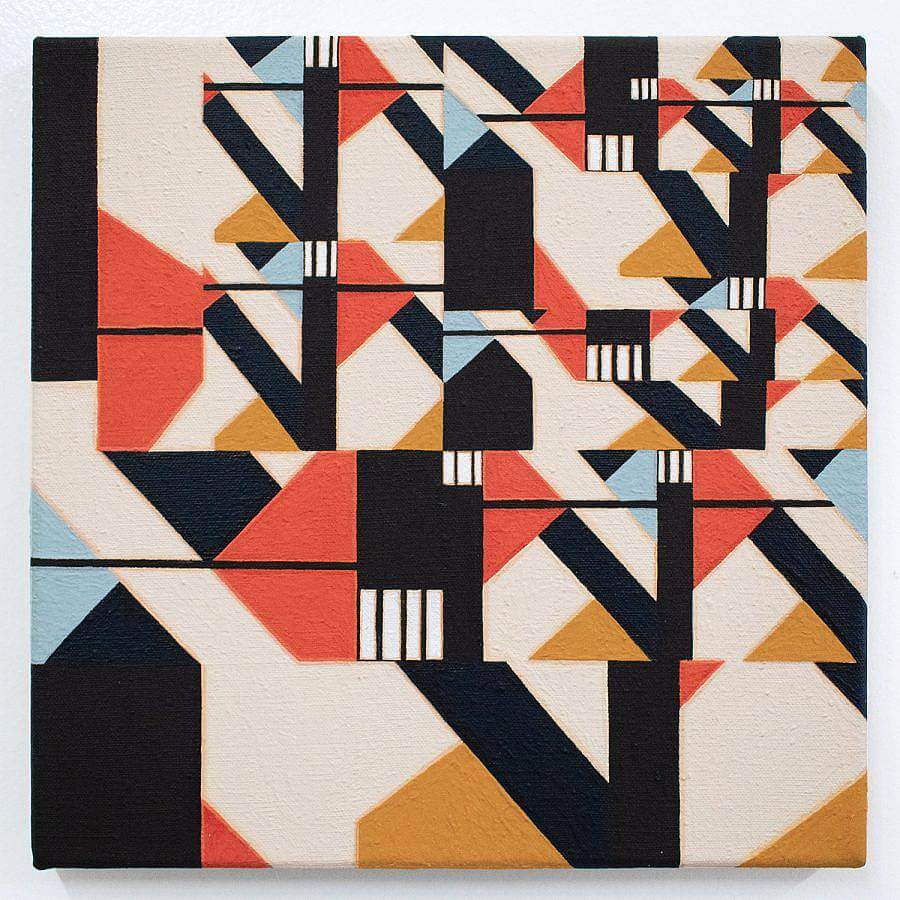
How do you think about installing or hanging your work? What kinds of formal or material considerations do you have?
I explore the relationships between painting and architectural space. I construct each panel, each tablet, each sculpture I make from common materials. Because I build every part of each piece I have a connection to them from the very beginning all the way to the install. I often refer back to one of Le Corbusier’s quotes where he stated that “Architecture is not simply a platform that accommodates the viewing subject. It is a viewing mechanism that produces the subject. It precedes and frames the occupant” This quote has shaken the core of my practice recently because now I’m taking into consideration how my work is displayed. It’s important for me to explore the essential relationships between form, composition, and space. I want to invite the viewer into a more heightened experience.
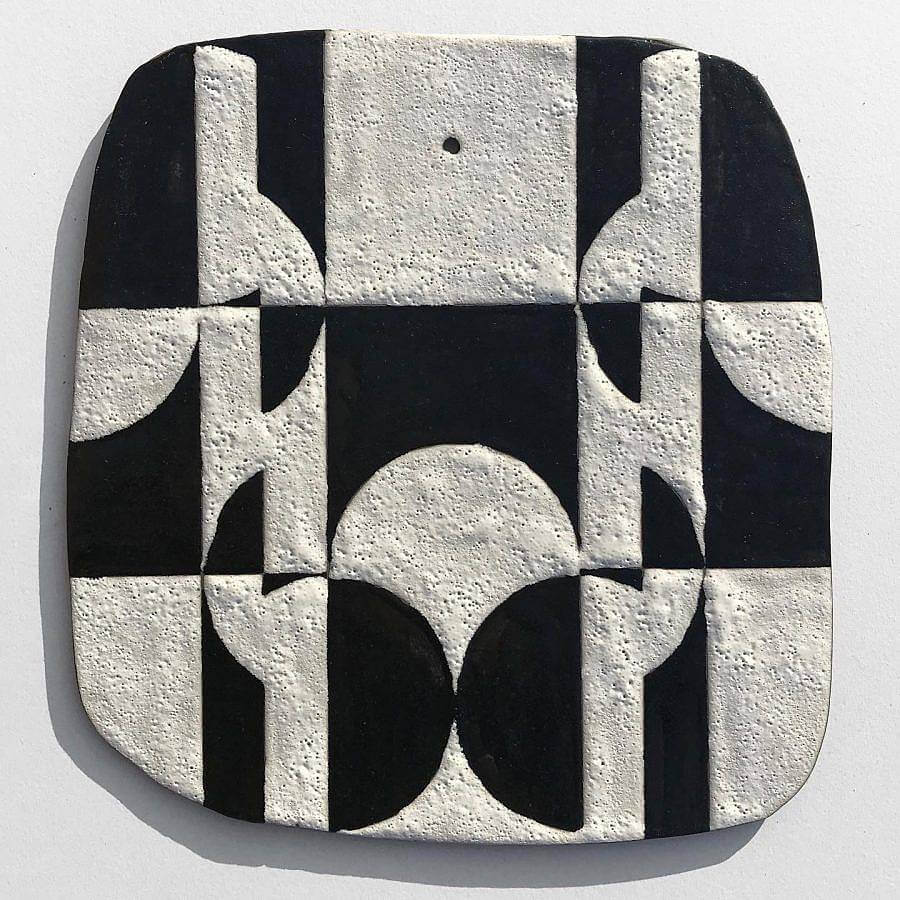
Who are some of your favorite artists or designers?
I have so many favorites! All of the legends like Anni Albers, Joe Overstreet, Nathalie Du Pasquier, Le Corbusier, Charlotte Perriand, Dieter Rams, Paul Klee, Francis Picabia, Jack Youngerman, Lyubov Popova.
I’m lucky to be involved in friendly dialog with a lot of my favorites, these are people who encourage me and inspire me every day. Angela Heisch, Paolo Arao, RRRES, Carrie Moyer, Johnny Abrahams, Camille Wallala, Dan Walsh, Amie Cunat, Sean Sullivan, Pedro Reyes.
Interview conducted and edited by Maddy Olson
